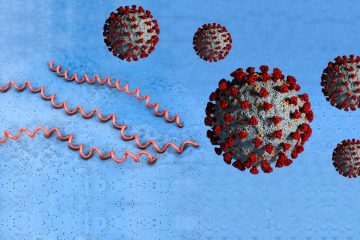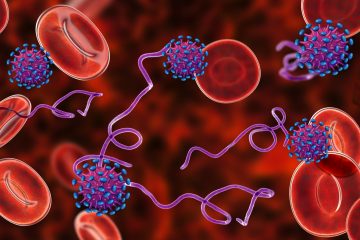An Alphabet Soup of Co-Infections Complicates Diagnosis and Treatment of Lyme Disease Ticks spread pandora's box of pathogens
- QWhat are these “co-infections” and “associated diseases?
- AThe ticks that carry the Lyme bacteria also often carry microorganisms that cause other diseases. The most common co-infections are anaplasmosis, ehrlichiosis, babesiosis, bartonellosis, and Rocky Mountain spotted fever. Anaplasmosis, ehrlichiosis, and Rocky Mountain spotted fever may be cured by the same antibiotics that are prescribed for Lyme disease. But babesiosis is a different type of disease, caused by a blood parasite and not a bacterium. Antibiotics alone are not effective against babesiosis. Bartonellosis is a bacterial disease, but it requires different antibiotics from those used to treat Lyme disease. All are found in ticks, but some, like bartonellosis, may be spread more often from flea bites.
- QWhat are these new tick-borne diseases I have read about?
- AThere are newly-discovered species of tick-borne borrelia that can cause different symptoms. Borrelia mayonii causes symptoms similar to Lyme disease, but nausea and vomiting are more common with this infection and the rash is different from the bull’s-eye rash of Lyme disease. It has been identified mostly in Wisconsin and Minnesota to date.
Borrelia miyomotoi causes recurrent fevers, along with other symptoms common in Lyme Disease. It has been identified mostly in the northeastern U.S. The effects of this disease are somewhat different and more intense than in typical Lyme disease. It can be acquired from the bite of a larval deer tick, which is too small for most people to even recognize as a tick. Doxycycline is used to initially treat both of these new Lyme disease variants. Little is known about these diseases at this time.
Powassan fever is a serious viral infection that can be fatal. Half of the patients contracting this disease will have permanent neurological damage. This disease causes serious neurological symptoms, including brain and spinal cord inflammation, severe headache, stiff neck, and seizures, as well as many of the other symptoms caused by Lyme disease. There is a diagnostic test, but few labs are capable of doing the test. There is no treatment except supportive care. According to CDC records, about 11% of patients die from Powassan fever. It is still relatively rare, with fewer than 100 cases reported to the CDC since 2004, but there may be many more undiagnosed cases. Powassan fever can be transmitted in as little as 15 minutes after a tick attaches.
Heartland and Bourbon viruses are other recently discovered tick-borne diseases, that can be deadly. They have been found mostly in Missouri and Tennessee, spread by infected lone-star ticks. There is evidence that other biting insects might also spread these diseases. There is no test and no treatment. They are still rare diseases.
Morgellons disease is an emerging disease that causes strange symptoms. It is the least understood and most controversial of the tick-borne diseases. One unique characteristic of Morgellons is the appearance of fibers growing out of the skin, accompanied by severe itching. Morgellons patients often experience sensations of something crawling under their skin, which leads many doctors to conclude that the patient has a psychiatric problem. However, experiments have shown that dogs can have the same fibers and symptoms. New organisms such as viruses and microscopic worms are being discovered in ticks. Their role in human illness is not yet known.
- QWhy do some people develop an allergy to red meat after a tick bite?
- AThis is a new and mysterious condition that seems to be related to the bite of the Lone Star tick. It causes some people to develop a serious, and sometimes life-threatening, reaction to eating beef, pork, and sometimes milk. It is not known yet if this is a permanent condition. Epinephrine may be required in the case of a serious reaction. Lone star ticks have spread from the South and Southwest to much of the rest of the U.S. in recent years. They are much more aggressive than deer ticks.
- QHow does my doctor know if I have these emerging coinfections?
- AFew doctors are familiar with these other tick-borne diseases. They may fail to recognize the symptoms or test for these diseases, so many people are suffering from untreated infections. The lab tests for these coinfections have many of the same problems as Lyme disease tests. Often it is this combination of diseases that makes the patient so mystifyingly ill and unresponsive to treatment. If treatment for Lyme disease is unsuccessful, suspect tick-borne co-infections.
- QWhat are the symptoms of anaplasmosis or ehrlichiosis?
- ALike Lyme disease, anaplasmosis and ehrlichiosis infections peak during May, June, and July and the symptoms typically appear from a week to a month after infection. The initial symptoms are flu-like and can include high fever, chills, headache, fatigue, and general achiness. Fewer than half of infected people report a rash. The rash is different from a Lyme disease rash; it is usually smaller and may have raised areas. The rash is more common in children than adults. Children may also suffer from swelling of the hands and feet. Other symptoms may develop later, including nausea, diarrhea or constipation, loss of appetite, cough, stiff neck, confusion, and weight loss. Untreated, the disease can sometimes be fatal in a few weeks, especially in children.
- QHow are anaplasmosis and ehrlichiosis diagnosed?
- AThere are blood tests for anaplasmosis and ehrlichiosis, which vary in accuracy and reliability depending on when the test is performed and the lab performing the test. It is difficult to obtain an accurate test result during the first few weeks after infection.
- QHow are anaplasmosis and ehrlichiosis treated?
- AAnaplasmosis and ehrlichiosis are usually treated with doxycycline. Most cases respond quickly when diagnosed and treated promptly. However, about 1-2% of these patients will die if treatment is not initiated right away. Like Lyme disease, you can get these diseases over and over again from new tick bites.
- QWhat are the symptoms of babesiosis?
- APeople with babesiosis sometimes have no symptoms at all. However, it can be life-threatening for someone with a suppressed immune system. It is also more serious for people over age 50. Symptoms are often the same as for Lyme disease, but there may also be a very high fever of up to 104°F, and anemia. Drenching night sweats, chills, severe headaches, fatigue, “air hunger,” and sleep disturbances are common. You can get babesiosis from a blood transfusion from an infected donor.
- QHow is babesiosis diagnosed?
- AThere are blood tests, but test reliability declines a few weeks after infection. These tests suffer from the same lack of sensitivity that plagues Lyme disease testing. PCR tests for babesiosis can be useful if positive, but a negative result does not rule out the disease. Examining the red blood cells under a microscope may reveal the parasites, but few diagnostic laboratories are skilled at the tedious job of carefully observing the blood cells.
- QWhat is the treatment for babesiosis?
- AIt is important to remember that babesiosis is caused by a protozoan parasite and not by a bacterium, so antibiotics alone will not cure this disease. Many people appear to recover without treatment, but the disease may flare up later. Since babesiosis is closely related to malaria, anti-malarial drugs are used to treat it. Usually an atovaquone drug like Mepron or Malarone is used along with an antibiotic such as azithromycin; the combination increases the effectiveness of the treatment. As with most tick-borne diseases, you do not develop any immunity after infection and you can get Babesiosis over and over.
- QWhat are the symptoms of bartonellosis?
- AEarly bartonellosis symptoms are often similar to Lyme disease symptoms. There may be a rash, but the rash is different from a Lyme disease bull’s eye and may look like long, thin red areas, somewhat like stretch marks. In many people bartonellosis is a mild disease and the symptoms subside on their own. But in some cases, Bartonellosis may cause ongoing fatigue, depression, anxiety, headaches, swollen glands, sore soles of the feet, GI problems, arthritis, generalized aches and pains similar to those of other tick-borne diseases, seizures, neurological disorders, and even dementia. Vision loss and eye infections may occur. As with some of the other tick-borne diseases, the symptoms of Bartonellosis tend to come and go. Some areas have a very high rate of Bartonellosis organisms in ticks, sometimes much higher than the rate for Lyme bacteria. Research has shown that Bartonellosis may be more often transmitted by fleas than by ticks.
- QHow is bartonellosis diagnosed?
- AThere are blood tests, but as with other tick-borne diseases, the tests are often inaccurate. Some doctors report success with a series of PCR tests, but tick-borne bartonellosis has not been recognized long enough to have a reliable diagnostic testing procedure. Few doctors are familiar with tick-borne bartonellosis. The cause of tick-borne bartonellosis is a bacterium similar to one that causes “cat scratch disease,” which typically is far less serious and has different symptoms.
- QWhat is the treatment for Bartonellosis?
- AAntibiotics are used to treat bartonellosis, but the antibiotics used to treat Lyme disease are usually not effective for bartonellosis. As with the other tick-borne diseases, treatment time can be lengthy. Since this disease has been recognized only recently, doctors are still learning which drugs are best. Levaquin, azithromycin, and Rifampin are commonly used to treat bartonellosis.
- QWhat are the symptoms of Rocky Mountain spotted fever?
- ADespite its name, Rocky Mountain spotted fever (RMSF) is far more prevalent in the South and East than it is in the Rocky Mountains. Like Lyme disease, it is caused by a bacterium. Untreated, it can sometimes be a fatal disease. It is spread by dog ticks as well as deer ticks. After two to fourteen days, most infected people suffer from fevers (sometimes 102°F or higher), headache, and achiness. Most people will develop a rash, which may begin around the wrists and ankles but sometimes starts on the trunk. A classic symptom is a rash on the palms and soles of the feet, but fewer than half of the patients will have that. Untreated, about half of the people infected with RMSF will develop permanent neurological problems. If you handle a tick while removing it, be sure to wash your hands thoroughly to minimize your risk of infection with RMSF. There are reports of infection simply from contact with an infected tick.
- QHow is Rocky Mountain spotted fever diagnosed?
- ARMSF requires a clinical diagnosis, which means that it is up to your doctor to evaluate your signs and symptoms to determine if you have the disease. Early blood tests are not accurate.
- QHow is Rocky Mountain spotted fever treated?
- ADoxycycline is the recommended antibiotic for RMSF.
- QAre there other co-infections?
- ANew tick-borne diseases are being discovered all the time, and some established diseases are being diagnosed more often. New Borrelia species include Borrelia miyamotoi and Borrelia mayonii, which are emerging diseases that cause somewhat different symptoms than Lyme disease. Southern Tick-Associated Rash Illness (STARI) seems to share many symptoms with Lyme disease but it may be caused by a different Borrelia species. Colorado Tick Fever, Heartland Virus, and Powassan Virus are caused by viruses and not bacteria.
tick-borne diseases, published by Lyme Disease Association of Southeastern Pennsylvania, Inc., a not-for-profit 501(c)(3) corporation and an affiliate of the Lyme Disease Association, Inc. Learn more at www.LymePa.org
Editor’s note: Any medical information included is based on a personal experience. For questions or concerns regarding health, please consult a doctor or medical professional.





























